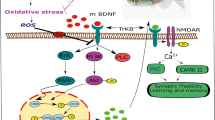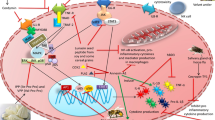Abstract
Stigmasterol is a common sterol found in plants, but the anti-nociceptive effect of this compound and its mechanism of action are not fully explored. Thus, in the present study, the anti-nociceptive effect of stigmasterol was investigated in acute and chronic models of pain and its mechanism of action. We used adult male albino Swiss mice (25–35 g) to observe the anti-nociceptive effect of stigmasterol in acetic-acid writhing test or in complete Freund’s adjuvant injection, surgical incision in hind paw, or partial sciatic nerve ligation. Moreover, we investigate the involvement of opioid receptors (naloxone, 2 mg/kg, intraperitoneally) in stigmasterol anti-nociceptive effect and stigmasterol action on acetylcholinesterase activity. Some possible adverse effects caused by stigmasterol were also investigated. Stigmasterol (0.3–3 mg/kg, orally) exhibited an anti-nociceptive effect on acetic-acid-induced writhing test. Furthermore, it markedly attenuated the mechanical allodynia caused by surgical incision (after acute treatment with stigmasterol, preventive and curative effects were observed) and partial sciatic nerve ligation (after acute treatment with stigmasterol) and complete Freund’s adjuvant (after acute or repeated treatment with stigmasterol). The anti-nociceptive effect of stigmasterol was not reversed by naloxone. Moreover, stigmasterol did not alter in vitro acetylcholinesterase activity in spinal cord or brain samples. Also, stigmasterol did not cause gastric ulcers or alter the gastrointestinal transit of mice. Taken together, these results support the potential anti-nociceptive effect of stigmasterol in different models of pain.






Similar content being viewed by others
Abbreviations
- AChE:
-
Acetylcholinesterase
- CFA:
-
Complete Freund’s adjuvant
- DTNB:
-
5,5′-Dithiobis(2-nitrobenzoic acid)
- i.p.:
-
Intraperitoneally
- p.o.:
-
Orally
- PBS:
-
Phosphate-buffered solution
- s.c.:
-
Subcutaneously
References
Ali H, Dixit S, Ali D, Alqahtani SM, Alkahtani S, Alarifi S (2015) Isolation and evaluation of anticancer efficacy of stigmasterol in a mouse model of DMBA-induced skin carcinoma. Drug Des Devel Ther 28:2793–2800
Atanasov AG, Waltenberger B, Pferschy-Wenzig EM, Linder T, Wawrosch C, Uhrin P, Temml V, Wang L, Schwaiger S, Heiss EH, Rollinger JM, Schuster D, Breuss JM, Bochkov V, Mihovilovic MD, Kopp B, Bauer R, Dirsch VM, Stuppner H (2015) Discovery and resupply of pharmacologically active plant-derived natural products: a review. Biotechnol Adv 33:1582–1614
Brennan TJ, Umali EF, Zahn PK (1997) Comparison of pre- versus post-incision administration of intrathecal bupivacaine and intrathecal morphine in a rat model of postoperative pain. Anesthesiology 87:1517–1528
Brum ES, Moreira LR, da Silva ARH, Boligon AA, Carvalho FB, Athayde ML, Brandão R, Oliveira SM (2016) Tabernaemontana catharinensis ethyl acetate fraction presents antinociceptive activity without causing toxicological effects in mice. J Ethnopharmacol 191:115–124
Brune K, Patrignani P (2015) New insights into the use of currently available non-steroidal anti-inflammatory drugs. J Pain Res 20:105–118
Calixto JB, Beirith A, Ferreira J, Santos AR, Filho VC, Yunes RA (2000) Naturally occurring antinociceptive substances from plants. Phytother Res 14(6):401–418
Cazacu I, Mogosan C, Loghin F (2015) Safety issues of current analgesics: an update. Clujul Medical 88:128
Chou R, Gordon DB, de Leon-Casasola OA, Rosenberg JM, Bickler S, Brennan T, Carter T, Cassidy CL, Chittenden EH, Degenhardt E, Griffith S, Manworren R, McCarberg B, Montgomery R, Murphy J, Perkal MF, Suresh S, Sluka K, Strassels S, Thirlby R, Viscusi E, Walco GA, Warner L, Weisman SJ, Wu CL (2016) Management of Postoperative Pain: a Clinical Practice Guideline from the American Pain Society, the American Society of Regional Anesthesia and Pain Medicine, and the American Society of Anesthesiologists’ Committee on Regional Anesthesia, Executive Committee, and Administrative Council. J Pain 17:131–157
Cohen SP, Mao J (2014) Neuropathic pain: mechanisms and their clinical implications. BMJ 348:f7656
Dixon WJ (1980) Efficient analysis of experimental observations. Annu Rev Pharmacol Toxicol 20:441–462
Ferreira J, Campos MM, Pesquero JB, Araújo RC, Bader M, Calixto JB (2001) Evidence for the participation of kinins in Freund’s adjuvant-induced inflammatory and nociceptive responses in kinin B1 and B2 receptor knockout mice. Neuropharmacology 41:1006–1012
Ferreira J, Beirith A, Mori MA, Araújo RC, Bader M, Pesquero JB, Calixto JB (2005) Reduced nerve injury-induced neuropathic pain in kinin B1 receptor knock-out mice. J Neurosci 25:2405–2412
Finnerup NB, Attal N, Haroutounian S, McNicol E, Baron R, Dworkin RH, Gilron I, Haanpää M, Hansson P, Jensen TS, Kamerman PR, Lund K, Moore A, Raja SN, Rice AS, Rowbotham M, Sena E, Siddall P, Smith BH, Wallace M (2015) Pharmacotherapy for neuropathic pain in adults: a systematic review and meta-analysis. Lancet Neurol 14:162–173
Fiorino DF, Garcia-Guzman M (2012) Muscarinic pain pharmacology: realizing the promise of novel analgesics by overcoming old challenges. Handb Exp Pharmacol 208:191–221
Gabay O, Sanchez C, Salvat C, Chevy F, Breton M, Nourissat G, Wolf C, Jacques C, Berenbaum F (2010) Stigmasterol: a phytosterol with potential anti-osteoarthritic properties. Osteoarthr Cartil 18:106–116
Gade S, Rajamanikyam M, Vadlapudi V, Nukala KM, Aluvala R, Giddigari C, Karanam NJ, Barua NC, Pandey R, Upadhyayula VS, Sripadi P, Amanchy R, Upadhyayula SM (2016) Acetylcholinesterase inhibitory activity of stigmasterol & hexacosanol is responsible for larvicidal and repellent properties of Chromolaena odorata. Biochim Biophys Acta 1861:541–550
Gregory NS, Harris AL, Robinson CR, Dougherty PM, Fuchs PN, Sluka KA (2013) An overview of animal models of pain: disease models and outcome measures. J Pain 14:1255–1269
Hamann FR, Zago AM, Rossato MF, Beck VR, Mello CF, de Brum TF, de Carvalho LM, Faccin H, Oliveira SM, Rubin MA (2016) Antinociceptive and antidepressant-like effects of the crude extract of Vitex Megapotamica in rats. J Ethnopharmacol 192:210–216
Huo Y, Guo C, Zhang QY, Chen WS, Zheng HC, Rahman K, Qin LP (2007) Antinociceptive activity and chemical composition of constituents from Caragana Microphylla seeds. Phytomedicine 14:143–146
Kaur N, Chaudhary J, Jain A, Kishore L (2011) Stigmasterol: a comprehensive review. Int J Pharm Sci Res 2:2259–2265
Latremoliere A, Woolf CJ (2010) Central sensitization: a generator of pain hypersensitivity by central neural plasticity. J Pain 10:895–926
Li C, Liu Y, Xie Z, Lu Q, Luo S (2015) Stigmasterol protects against Ang II-induced proliferation of the A7r5 aortic smooth muscle cell-line. Food Funct 6:2266–2272
Lolignier S, Eijkelkamp N, Wood JN (2015) Mechanical allodynia. Pflugers Arch 467:133–139
Magistretti MJ, Conti M, Cristoni A (1988) Antiulcer activity of an anthocyanidin FromVacciniummyrtillus. Arzneimittelforschung 38:686–690
Mathews M (2014) Multimodal treatment of pain. Neurosurg Clin N Am 25:803–808
Milano J, Oliveira SM, Rossato MF, Sauzem PD, Machado P, Beck P, Zanatta N, Martins MA, Mello CF, Rubin MA, Ferreira J, Bonacorso HG (2008) Antinociceptive effect of novel trihalomethyl-substituted pyrazoline methyl esters in formalin and hot-plate tests in mice. Eur J Pharmacol 26:86–96
Negus SS, Vanderah TW, Brandt MR, Bilsky EJ, Becerra L, Borsook D (2006) Preclinical assessment of candidate analgesic drugs: recent advances and future challenges. J Pharmacol Exp Ther 319:507–514
McEntire DM, Kirkpatrick DR, Dueck NP, Kerfeld MJ, Smith TA, Nelson TJ, Reisbig MD, Agrawal DK (2016) Pain transduction: a pharmacologic perspective. Expert Rev Clin Pharmacol 9:1069–1080
Mora-Ranjeva MP, Charveron M, Fabre B, Milon A, Muller I (2006) Incorporation of phytosterols in human keratinocytes. Consequences on UVA-induced lipid peroxidation and calcium ionophore-induced release. Chem Phys Lipids 141:216–224
Moreira LR, Brum ES, da Silva ARH, de Freitas ML, Teixeira TP, Boligon AA, Athayde ML, Duarte T, Duarte MMMF, Oliveira SM, Brandão R (2016) Antinociceptive and anti-inflammatory effect of the Scutia buxifolia Reissek stem barks extract. Phytomedicine 23:1021–1028
Oliveira SM, Gewehr C, Dalmolin GD, Cechinel CA, Wentz A, Lourega RV, Sehnem RC, Zanatta N, Martins MA, Rubin MA, Bonacorso HG, Ferreira J (2009) Antinociceptive effect of a novel tosylpyrazole compound in mice. Basic Clin Pharmacol Toxicol 104:122–129
Oliveira SM, Drewes CC, Silva CR, Trevisan G, Boschen SL, Moreira CG, de Almeida CD, Da Cunha C, Ferreira J (2011) Involvement of mast cells in a mouse model of postoperative pain. Eur J Pharmacol 672:88–95
Pacheco DF, Freitas ACN, Pimenta AMC, Duarte IDG, de Lima ME (2016) A spider derived peptide, PnPP-19, induces central antinociception mediated by opioid and cannabinoid systems. J Venom Anim Toxins Incl Trop Dis 22:34
Pereira ME, Adams AIH, Silva NS (2004) 2,5-Hexanedione inhibits rat brain acetylcholinesterase activity in vitro. Toxicol Lett 146:269–274
Pogatzki-Zahn EM, Zahn PK, Brennan TJ (2007) Postoperative pain—clinical implications of basic research. Best Pract Res Clin Anaesthesiol 21:3–13
Porreca F, Mosberg HI, Omnaas JR, Burks TF, Cowan A (1987) Supraspinal and spinal potency of selective opioid agonists in the mouse writhing test. J Pharmacol Exp Ther 240:890–894
Ramu R, Shirahatti PS, Nayakavadi SRV, Zameer F, Dhananjaya BL, Prasad MN (2016) The effect of a plant extract enriched in stigmasterol and β-sitosterol on glycaemic status and glucose metabolism in alloxan-induced diabetic rats. Food Funct 7:3999–4011
Roeckel LA, Le Coz GM, Gavériaux-Ruff C, Simonin F (2016) Opioid-induced hyperalgesia: cellular and molecular mechanisms. Neuroscience 338:160–182
Rossato MF, Trevisan G, Walker CIB, Klafke JZ, de Oliveira AP, Villarinho JG, Zanon RB, Royes LFF, Athayde ML, Gomez MV, Ferreira J (2011) Eriodictyol: a flavonoid antagonist of the TRPV1 receptor with antioxidant activity. Biochem Pharmacol 81:544–551
Santos AR, Niero R, Filho VC, Yunes RA, Pizzolatti MG, Delle Monache F, Calixto JB (1995) Antinociceptive properties of steroids isolated from Phyllanthus corcovadensis in mice. Planta Med 61:329–332
Trevisan G, Maldaner G, Velloso NA, Sant'Anna G da S, Ilha V, Velho Gewehr C de C, Rubin MA, Morel AF, Ferreira J (2009) Antinociceptive effects of 14-membered cyclopeptide alkaloids. J Nat Prod. 72:608-12.
Trevisan G, Rossato MF, Walker CI, Klafke JZ, Rosa F, Oliveira SM, Tonello R, Guerra GP, Boligon AA, Zanon RB, Athayde ML, Ferreira J (2012) Identification of the plant steroid α-spinasterol as a novel transient receptor potential vanilloid 1 antagonist with antinociceptive properties. J Pharmacol Exp Ther 343:258–269
Walker CIB, Trevisan G, Rossato MF, Franciscato C, Pereira ME, Ferreira J, Manfron MP (2008) Antinociceptive activity of Mirabilis jalapa in mice. J Ethnopharmacol 120:169–175
Walker CIB, Trevisan G, Rossato MF, Silva CR, Pinheiro FV, Franciscato C, Tatsch E, Moretto MB, Silva MD, Manfron MP, Noal Moresco R, Santos AR, Pereira ME, Ferreira J (2013) Antinociceptive effect of Mirabilis jalapa on acute and chronic pain models in mice. J Ethnopharmacol 149:685–693
Wess J, Eglen RM, Gautam D (2007) Muscarinic acetylcholine receptors: mutant mice provide new insights for drug development. Nat Rev Drug Discov 6:721–733
Yoon MH, Choi JI, Jeong SW (2003) Antinociception of intrathecal cholinesterase inhibitors and cholinergic receptors in rats. Acta Anaesthesiol Scand 47:1079–1084
Zeb A, Ahmad S, Ullah F, Ayaz M, Sadiq A (2016) Anti-nociceptive activity of ethnomedicinally important analgesic plant Isodon rugosus wall. ex Benth: mechanistic study and identifications of bioactive compounds. Front Pharmacol 7:200
Zimmermann M (1983) Ethical guidelines for investigations of experimental pain in conscious animals. Pain 16:109–110
Acknowledgments
This study was supported by Conselho Nacional de Desenvolvimento Científico (CNPq) and by Financiadora de Estudos e Projetos (FINEP). The fellowships from CNPq and CAPES are also acknowledged.
Author information
Authors and Affiliations
Corresponding authors
Ethics declarations
Conflict of interest
The authors declare that they have no conflict of interest.
Rights and permissions
About this article
Cite this article
Walker, C.I.B., Oliveira, S.M., Tonello, R. et al. Anti-nociceptive effect of stigmasterol in mouse models of acute and chronic pain. Naunyn-Schmiedeberg's Arch Pharmacol 390, 1163–1172 (2017). https://doi.org/10.1007/s00210-017-1416-x
Received:
Accepted:
Published:
Issue Date:
DOI: https://doi.org/10.1007/s00210-017-1416-x




